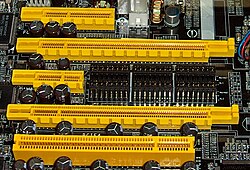Address bus
An address bus is a computer bus architecture. It carries the addresses from the CPU to memory and I/O devices, specifying which location is being accessed. The address is stored in the form of binary numbers to enable the data bus to access memory storage.
Address buses are made up of a collection of wires connecting the CPU with main memory that is used to identify particular addresses in main memory. The width of the address bus (that is, the number of wires) determines how many unique memory locations can be addressed. Modern personal computers and Macintoshes have as many as 36 address lines. This theoretically allows them to access 64 gigabytes of main memory. The actual amount of memory that can be accessed is usually much less than this theoretical limit due to chipset and motherboard limitations.
An address bus is part of the system bus architecture. Most modern computers use a variety of individual buses for specific tasks.
An individual computer contains a system bus, which connects the major components of the computer system and has three main elements, of which the address bus is one, along with the data bus and control bus.
When you access a memory address in software, you are referring to an address within the addressable memory space defined by the address bus width. For example, in a system with a 16-bit address bus, the address range is from 0x0000 to 0xFFFF (64 KB).
Address Bus Media
Four PCI Express bus card slots (from top to second from bottom: ×4, ×16, ×1 and ×16), compared to a 32-bit conventional PCI bus card slot (very bottom)

